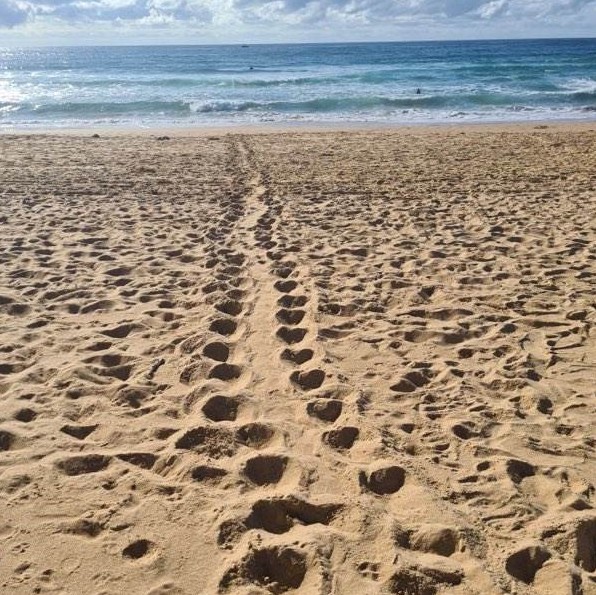A large operation is underway to protect a rare nest of endangered Loggerhead Turtle eggs discovered at Shelly Beach, with residents asked to help.
Two surprised beach walkers found the nest after seeing a turtle crawl into the waves, and promptly called WIRES at 5.30am one day last week, triggering alerts to NSW National Parks and Wildlife Service (NPWS), NSW TurtleWatch and Central Coast Council.
Council’s Director Environment and Planning Alice Howe said Council has built a temporary fence around 15m2 of the sand dune to protect the site and is calling on the community to help as well.
“It’s exciting and extremely rare to have a Loggerhead nest in the dunes here, which is why it’s important people remain outside the fenced area and obey the signs to help keep them safe,” Howe said.
“The mother has buried the nest a short distance below the sand surface, in an area popular with beachgoers.
“People could inadvertently crush eggs or collapse the nest simply by walking over the top.
“Predators also pose a risk – such as foxes or dogs digging up the eggs, as well as goannas and birds, all of which are potential egg thieves and nest raiders.”
NPWS Marine Wildlife Team Leader Duane March said the nest is of great interest to turtle conservationists as it is unusually far south.
“This southern shift in nesting could be attributed to warmer water temperatures being experienced further south on the east coast of Australia in recent years,” he said.
“Climate change is a massive threat to sea turtles, as increasing nest temperatures further north are producing more female hatchlings.
“So to have a nest in a cooler climate that will produce predominantly male hatchlings is important for this species’ long-term viability.”
NSW TurtleWatch coordinator Holly West said the prompt call to wildlife rescuers may end up saving the nest.
“Creating community awareness is key to ensuring the eggs are protected from harm and have the best chance to hatch, so the nest will be monitored closely by staff and volunteers,” she said.
“A big thanks to beachgoers for understanding the need for the temporary exclusion fencing, which will be removed as soon as the eggs have hatched.”
Experts from the three organisations anticipate the nest has between 100 and 150 turtle eggs which, depending on sand temperatures, could hatch in around 8-12 weeks’ time.

Loggerhead turtles (Caretta caretta) are endangered on the Australian east coast and have an amazing life cycle that takes them all the way to South America.
Once they mature and return to Australian waters, Loggerhead Turtles breed on the Great Barrier Reef’s southern islands, or southern Queensland beaches, with only a small number nesting on NSW beaches each year.
Numbers have declined in the past 20 years.
On shore, turtle nests are impacted by predators, development, light pollution, climactic impacts from storm surges, erosion and sea inundation.
Off-shore threats include marine debris, ship strike and climate change.
One of the main threats to Loggerhead Turtles is being caught in fishing nets as “by-catch” while journeying from Australia to south and central American waters.
NSW TurtleWatch is a citizen science nesting program with volunteers collecting valuable data on marine turtles nesting and potential threats in NSW.
It has been developed by Australian Seabird and Turtle Rescue and supported by the NSW Government through its Saving our Species program, the Marine Estate Management Strategy and NSW National Parks and Wildlife Service.
Sea turtle nesting activity can be reported to NSW TurtleWatch on 0468 489 259.
Find out more by emailing turtlewatchnsw@gmail.com.
Source:
Media release, Jan 18
NPWS




